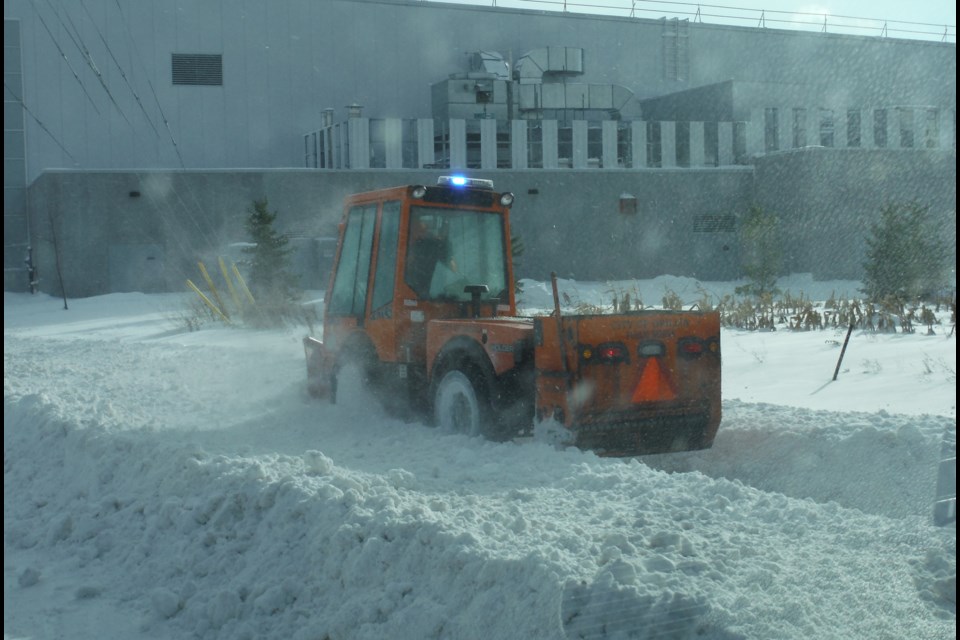On average, about 8.9 feet of snow fell each winter in Orillia from 1925 to 2017. But over the last 15 years, that average climbed to 10.9 feet and if you look at just the last five winters, the average is 12.5 feet of the white stuff.
“Climate change is definitely here,” says Andrew Schell, director of environmental services and operations for the city. “Even when you look at our five-year trend, the only reason it’s so low is we had one winter, 2014, where there was almost no snow. That number could be even more dramatic.”
More snow has meant more challenges for city workers. And in recent years, the biggest challenge has come at the worst time – in December, when people want to think about buying Christmas presents, not navigating through slippery roads and snow-filled sidewalks.
“In December of 2016, we received 182 centimetres of snow,” explained Kyle Mitchell, the city’s manager of source protection and operations. “In December of 2017, we received 178 centimetres. The average for December is 77 centimetres, so we’ve had two consecutive crazy Decembers.”
And that avalanche of white has led to a mountain of red ink for the city. Before this winter even began in November, the city had already spent its entire 2017 winter control budget of $1.398 million. While final numbers aren’t in, Schell estimates the city spent an additional $400,000 in November and December – money that was not budgeted, but that was anticipated, said treasurer Jim Lang.
“We knew at the end of last winter (January to April) that the budget was fully spent and council was aware of it,” said Lang. “Each year, there are some good news items and some bad news items in the budget … obviously, this falls under bad news. But, I fully expect” that the good news items will offset the extra spending needed.
However, even if that wasn’t the case, the city has a tax-rate stabilization reserve that has a balance of about $1.4 million; that reserve is for contingencies like this, said Lang. The bottom line, officials agree, is that no matter the budget status, the snow must be cleared. “We don’t stop the plows because we can’t stop the snow,” said Schell. “Work is done accordingly and we have to pay accordingly … and council is fine with that.”
But not all citizens are fine with the city’s snow-clearing efforts. During storms in December, a flurry of complaints piled up on social media channels. A similar storm of controversy erupted last December. “Our guys are well-seasoned and do a great job and they take (complaints) to heart, but sometimes you just can’t get there as fast as people want,” said Schell – especially when storms hit very early in the morning. “Our true wish is that snow would start at 6 at night and end at 11. Then our no-parking restriction on side-streets kicks in and the guys can get out and do their job. But, unfortunately, the trend lately is snow in the mornings, which is the worst for us.”
Schell said staff “do not like plowing during the day when cars are parked” on the sides of busy streets. It can create more issues, takes longer and produces poor results.
The increased snow trend, coupled with the complaints and challenges, has prompted several reports to council from staff. “We were asked by council a number of times last year to think about how to improve services,” said Schell, noting growth in the city has meant it takes longer to complete routes – especially in areas like west Orillia, where density it higher and there is less room for “snow storage.”
As a result of those discussions, during recent budget deliberations, council approved the purchase of two additional plows. However, they won’t join the city’s fleet until late next winter. So, for now that fleet consists of eight plows, five sanders and one grader – for about 365 kilometres of roads.
“The minimum time it takes to plow a route, under optimal conditions, is about six hours, but that can go above eight hours depending on how much snow we have,” said Mitchell, who notes the city is broken up into eight routes. He said the addition of two plows will allow staff to decrease the routes’ distances, slashing the time it takes to complete a route to about 4.5 hours. “That means we can respond to these snowfall events in a shorter period of time.”
Many question how, or, more to the point, when plows are deployed. That is defined by policies approved by council. For main routes, such as West Street and Laclie Street, as soon as the accumulation reaches four centimetres, plows hit the roads. For residential streets, it’s after an accumulation of eight centimetres. “We try to get them out as soon as possible,” said Mitchell, who noted he recently began to allocate more staff to the night shift “to try to get that morning rush cleaned up before people are heading to work.”
Mitchell said they have 17 full-time staff and eight seasonal employees who ensure there is coverage seven days a week – 24 hours a day. There are 11 staff working days and 10 on nights so that at any time, the eight plow routes can be maintained.
Because roads are Priority 1, sidewalks take longer to clear. Mitchell said the city’s policy requires sidewalks to be plowed within 24 hours of eight centimetres of snow falling – on arterial routes and around schools. For side streets, that time bloats to 48 hours. The city has six sidewalk plows for about 120 kilometres of sidewalks. “They travel, on average, about 10 kilometres an hour, so it’s challenging,” said Mitchell.
